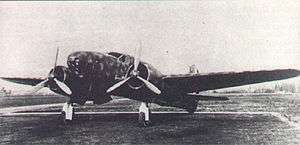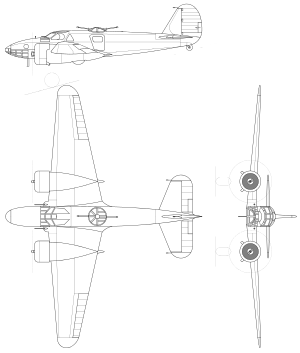Caproni Ca.310
| Ca.310 | |
|---|---|
 | |
| Caproni-Begamaschi Ca.310 | |
| Role | Reconnaissance |
| Manufacturer | Caproni |
| Designer | Cesare Pallavicino |
| First flight | April 1937 |
| Introduction | 1938 |
| Retired | 1948 |
| Primary users | Regia Aeronautica Hungarian Air Force Royal Norwegian Air Force Air Force of Peru |
| Number built | 312[1] |
| Variants | Caproni Ca.313 Caproni Ca.311 |
The Caproni Ca.310 Libeccio (Italian: southwest wind)[2] was an Italian monoplane, twin-engine reconnaissance aircraft used in World War II. Derived from the similar Ca.309, it had its combat debut during the Spanish Civil War and took part in the earlier phases of World War II in Libya. Some were used in attack groups as a temporary replacement for the unsatisfactory Breda Ba.65. The last Ca.310 was retired by the Italian Air Force in 1948.
Design and development
The Ca.310 was designed as a low-wing monoplane reconnaissance/bomber, being essentially a version of the semi-military Ca.309 with retractable landing gear and uprated engines. The fuselage was of welded steel tube construction with a covering of light alloy panels and fabric, while the empennage/tail unit was of wooden construction with plywood skin on its fixed portions and fabric covering on control surfaces.[3]
Above the fuselage, mounted in line with the wing trailing edges was a manually operated dorsal turret armed with a single rifle-caliber (7.7 mm/0.303 in) Breda-SAFAT machine gun.
Operational history

Caproni pinned great hopes on the Ca. 310's effectiveness as a combat aircraft, only to be dashed when its performance fell short of expectations. This lack of performance resulted in both Norway and Hungary being disappointed with the export models they received in 1938. The Ca.310 had been evaluated by the Regia Aeronautica (Italian Air Force) which ordered a small batch. A unit of 16 aircraft was sent to Spain in July 1938 for operational trials as a reconnaissance/bomber by the Italian expeditionary force operating alongside the Nationalist insurgents in the Spanish Civil War.
The Norwegian aircraft were acquired as part of a dried and salted cod (Klippfisk) barter deal between Norway and Italy.[4][5] The original order, including options, was for 24 aircraft, but after seeing that the aircraft did not perform well, the Norwegian authorities refused to accept any further Ca.310s. Instead, a delivery of 12 Caproni Ca.312s with upgraded engines and improved performance was substituted, but not delivered before the German invasion of Norway on 9 April 1940. A similar scenario occurred with other export contracts, especially with a hoped-for Royal Air Force order for bomber trainers being curtailed during negotiations with Caproni when Italy entered the war as an Axis power.[3]
A series of 12 Ca.310bis were produced for Yugoslavia. This variant differed mainly in having an unstepped, glazed nose. The prototype Ca.310bis served as the development for the Caproni Ca.311.
The 33 Hungarian Ca.310s returned to Italy were refurbished by Caproni and reissued to the 50˚ Stormo d’Assalto. The Ca.310 was not considered an effective combat aircraft and when it saw service during World War II, it was as a reconnaissance aircraft and as a light bomber in areas where no serious opposition was expected.[6]
Peruvian Aeronautical Corps Ca.310s took part in the July 1941 Ecuadorian-Peruvian war. Together with North American NA.50s, the Peruvian Ca.310s flew bombing missions against Ecuadorian cities[7] and supported Army of Peru ground forces.[8] One Norwegian example has been partially restored and is displayed at Sola Aviation Museum.
Variants
- Ca.310
- Twin-engined reconnaissance aircraft, powered by two Piaggio Stella P.VII C.16/35 seven-cylinder radial piston engines.
- Ca.310 Idro
- Twin-float seaplane version.
- Ca.310bis
- Effectively the prototype of the Caproni Ca.311 with the unstepped all-glazed nose and two Piaggio Stella P.VII C.35 engines
Operators
- Zrakoplovstvo Nezavisne Države Hrvatske operated seven captured ex-Yugoslav aircraft.
- Royal Hungarian Air Force ordered 36 examples in 1938, but returned the surviving 33 in 1940 after being unhappy with type's performance.
- Regia Aeronautica 193 aircraft [9]
- Aviazione Legionaria 16 aircraft[9]
- Italian Co-Belligerent Air Force
 Italy Postwar
Italy Postwar
- Norwegian Army Air Service operated four Ca.310s. Serial: 501, 503, 505 and 507
- Cuerpo de Aviación del Perú purchased 16 aircraft in 1938. 15 of them were delivered by ship in May 1938, and the last one was lost during the ferry flight from Italy to Peru on August 2, 1939, killing Capt. Pedro Canga Rodríguez and one of his crew members.
- Spanish Air Force -16 aircraft [10]
- Royal Yugoslav Air Force purchased 12 aircraft in 1938.
- SFR Yugoslav Air Force - Postwar.
Specifications (Ca.310)

Data from [3]
General characteristics
- Crew: three
- Length: 12.20 m (40 ft)
- Wingspan: 16.20 m (53 ft)
- Height: 3.52 m (11.5 ft)
- Wing area: 38.7 m² (127 ft²)
- Empty weight: 3,040 kg (6,702 lb)
- Loaded weight: 4,650 kg (10,251 lb)
- Powerplant: 2 × Piaggio Stella P.VII C.16/35, 350 kW (470 hp) each
Performance
- Maximum speed: 365 km/h (227 mph)
- Cruise speed: 285-312 km/h (177-194 mph)
- Range: 1,690 km (1,050 mi)
- Service ceiling: 7,000 m (22,966 ft)
Armament
- Guns: 3 × 7.7 mm (0.303 in) Breda SAFAT machine guns (2 × 7.7 mm/0.303 in machine guns fixed forward firing mounted in the wing roots; 1 × 7.7 mm/0.303 in machine gun in a dorsal turret)
- Bombs: up to 450 kg (992 lb)
See also
- Related lists
References
Notes
- ↑ Caproni Ca.310
- ↑ Glossary of Meteorology
- 1 2 3 Comando Supremo on the CA.310
- ↑ Norwegian Aircraft in 1940
- ↑ The Official Norwegian Defence Force website on the Norwegian Armed Forces Aircraft Collection: The inter-war years (Norwegian)
- ↑ Constable.ca: Caproni Ca 310 Reconnaissance Bomber "Libeccio" Archived October 23, 2007, at the Wayback Machine.
- ↑ Time.com: Shooting Scrape
- ↑ Acig.org: The Most Powerful Air Force in Latin America
- 1 2 Caproni Ca.310
- ↑ Caproni ca.310
Bibliography
- Bishop, Chris. The Complete Encyclopedia of Weapons of World War II. London: Brown Books, 1998. ISBN 1-897884-36-2.
- Mondey, David. The Concise Guide to Axis Aircraft of World War II. New York: Bounty Books, 1996. ISBN 1-85152-966-7.
- Taylor, M.J.H., ed. Jane's Encyclopedia of Aviation. London: Jane's Publishing Company, 1989. ISBN 1-85170-324-1.
External links
| Wikimedia Commons has media related to Caproni Ca.310. |
- Comando Supremo on the CA.310
- Constable.ca on the Ca.310
- World War 2 Aircraft: Caproni Bergamaschi CA 310 Series